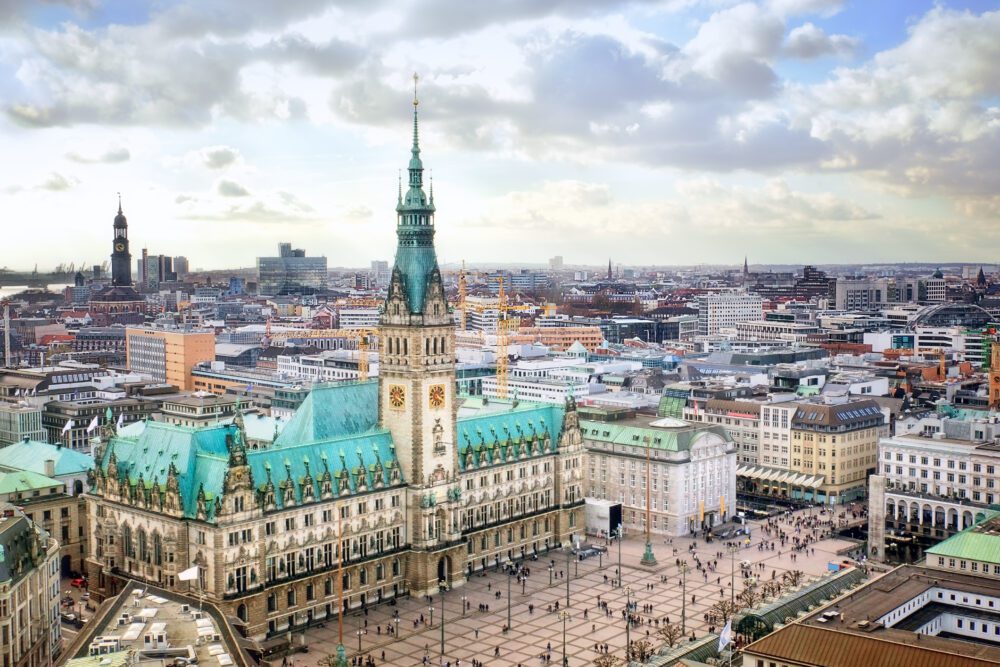
Introduction
Nestled along the Elbe River in northern Germany, Hamburg is a vibrant city that seamlessly blends rich history with modern innovation. As one of Germany’s major ports, Hamburg has long been a hub of commerce, culture, and maritime activity. Its maritime heritage is evident in the bustling port area, where ships from around the world dock and unload their cargo. Beyond its maritime connections, Hamburg is also known for its diverse neighbourhoods, green spaces, and cultural attractions. Whether you’re strolling along the picturesque waterfront, exploring historic districts, or indulging in culinary delights, Hamburg offers a dynamic and immersive experience for visitors of all ages.
With a history dating back over a thousand years, Hamburg has witnessed significant transformations over the centuries. From its origins as a medieval trading settlement to its emergence as a leading centre of trade and commerce in the Hanseatic League, Hamburg has played a pivotal role in shaping European history. Today, remnants of its storied past can be seen in its charming cobblestone streets, historic landmarks, and impressive architecture. Alongside its historical treasures, Hamburg boasts a thriving arts scene, world-class museums, and a reputation for culinary excellence. From the bustling fish market to the vibrant nightlife of the Reeperbahn, Hamburg offers a unique blend of old-world charm and modern excitement, making it an enticing destination for travellers seeking an unforgettable urban adventure.
Table of Contents
Map of the Best Things to Do in Hamburg
Hamburg Rathaus (City Hall)
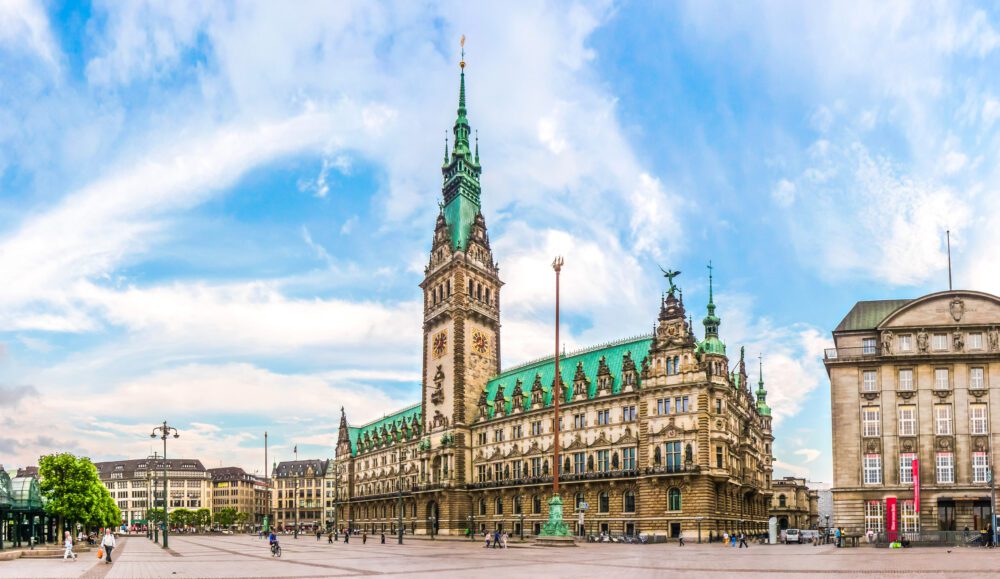
Hamburg City Hall, or Rathaus, stands as a magnificent testament to the city’s rich history and architectural grandeur. Constructed between 1886 and 1897 in the neo-Renaissance style, the Rathaus is a striking blend of red brick facades, ornate sculptures, and towering spires, making it one of Hamburg’s most iconic landmarks. Situated on the Rathausmarkt, the bustling square in the heart of the city, the Rathaus serves as the seat of Hamburg’s government and a focal point for civic life. Visitors to the Rathaus can marvel at its imposing facade, adorned with intricate stone carvings and statues representing figures from Hamburg’s history, as well as explore the opulent interiors, including the grand halls, council chambers, and ceremonial rooms.
Consider joining one of the guided tours offered by the Rathaus. Led by knowledgeable guides, these tours provide fascinating insights into the history, architecture, and significance of the building, allowing visitors to delve deeper into Hamburg’s rich cultural heritage. Be sure to check the Rathaus’s website for information on tour schedules, as well as any special events or exhibitions that may be taking place during your visit. After exploring the Rathaus, take time to wander around the Rathausmarkt, where you’ll find a bustling market square lined with cafes, shops, and historic buildings. Don’t miss the chance to sample some of Hamburg’s culinary delights, from freshly baked pastries to hearty traditional dishes, at one of the charming eateries dotted around the square.
Jungfernstieg and Alter Lake
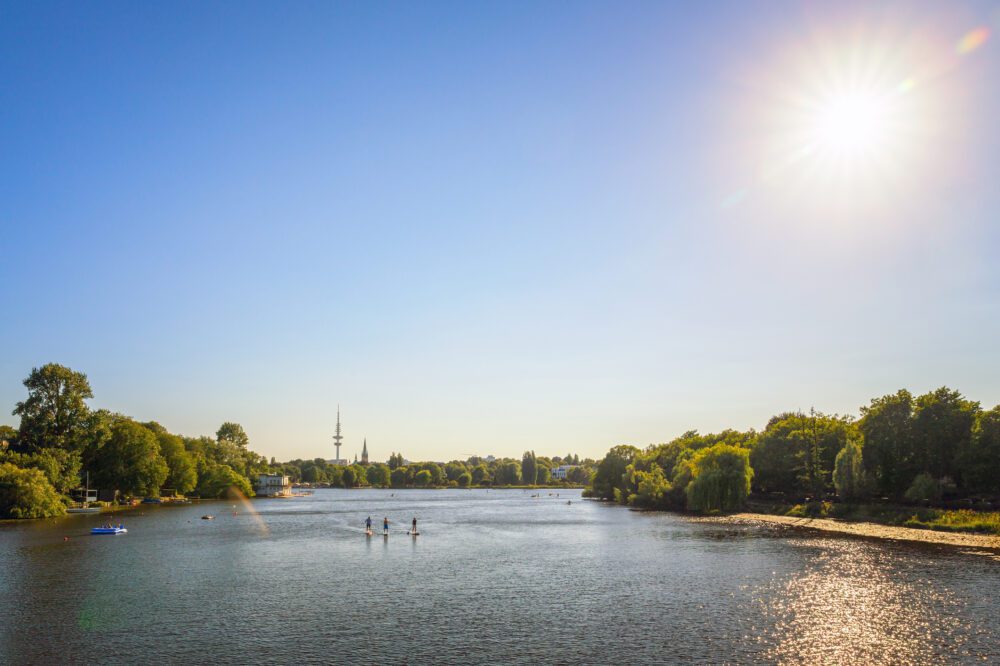
Jungfernstieg, a picturesque promenade along the banks of the Alster Lake, is one of Hamburg’s most iconic and beloved destinations. Dating back to the 19th century, Jungfernstieg was originally a walkway reserved for the ladies of Hamburg’s upper class, hence its name, which translates to “Maiden’s Walk.” Over the years, Jungfernstieg has evolved into a bustling thoroughfare lined with elegant buildings, boutiques, cafes, and restaurants, attracting locals and visitors alike. The promenade offers stunning views of Alster Lake and its surrounding greenery, making it a popular spot for strolls, romantic boat rides, and picnics by the water.
Start your visit with a leisurely walk along the promenade, taking in the scenic views of Alster Lake and the bustling activity along the waterfront. Consider renting a paddleboat or taking a boat tour to explore the lake from a different perspective and admire the city skyline from the water. Be sure to stop by the historic Alsterpavillon, a charming lakeside cafe and restaurant offering delicious cakes, pastries, and traditional German cuisine. If you’re visiting during the holiday season, don’t miss the chance to explore the Christmas market at Jungfernstieg, where you can shop for unique gifts, sample festive treats, and soak up the magical atmosphere of the season.
Hamburger Kunsthalle
The Hamburger Kunsthalle, one of Germany’s premier art museums, is a cultural gem nestled in the heart of Hamburg. Established in 1869, the museum has a rich history spanning over a century and a half, with a collection that encompasses works from the Middle Ages to the present day. The museum’s vast collection includes masterpieces by renowned artists such as Rembrandt, Rubens, Monet, Picasso, and Kandinsky, as well as significant works of German Romanticism and contemporary art. Divided into three main sections – the Old Masters Gallery, the 19th-century Art Gallery, and the Contemporary Art Gallery – the Hamburger Kunsthalle offers visitors a comprehensive overview of art history, from classical to modern and everything in between.
Plan to spend several hours exploring its extensive galleries and collections. Start your visit on the ground floor, where you’ll find the Old Masters Gallery, featuring works from the Middle Ages to the 18th century, including iconic paintings by Rembrandt and Rubens. Be sure to explore the museum’s upper floors, where you’ll discover the 19th-century Art Gallery, with its impressive collection of German Romanticism and Impressionism, as well as the Contemporary Art Gallery, showcasing cutting-edge works by contemporary artists. Consider joining one of the museum’s guided tours or audio guides, which provide fascinating insights into the artworks and the stories behind them.
Planten un Blomen

Planten un Blomen, which translates to “Plants and Flowers” in Low German, is a sprawling park located in the heart of Hamburg, offering a tranquil oasis amidst the bustling city streets. Established in 1821, Planten un Blomen has a rich history dating back over two centuries, evolving from a botanical garden into a beloved urban green space beloved by locals and visitors alike. The park spans over 47 hectares and features a diverse array of landscapes, including lush gardens, scenic ponds, and wooded areas, providing a serene retreat for nature lovers and outdoor enthusiasts. One of the park’s highlights is the famous water-light concert held at the park’s central lake, where illuminated fountains dance to music in a mesmerizing display of light and sound.
Start by exploring the park’s main attractions, including the Japanese Garden, the Rose Garden, and the Palm House. Be sure to check the park’s schedule for special events, performances, and exhibitions, such as the popular summer concerts and theatre productions held at the park’s open-air stage. For a leisurely afternoon, pack a picnic and find a shady spot beneath the trees or by the water, where you can relax and soak in the peaceful ambience of the park. Don’t forget to bring a camera to capture the park’s natural beauty, from vibrant flowers in bloom to colourful autumn foliage.
Hamburger Dom
Hamburger Dom, often simply referred to as “Dom,” is a centuries-old tradition and one of the largest and most famous folk festivals in northern Germany. Dating back to the 14th century, Dom originated as a market fair held by the Cathedral of St. Mary, thus earning its name “Dom,” which means cathedral in German. Over the years, the festival has evolved into a lively celebration featuring amusement rides, games, food stalls, and entertainment, attracting millions of visitors from near and far. Held three times a year – in spring, summer, and winter – Dom offers something for everyone, from thrilling roller coasters and spinning rides to traditional fairground games and delicious street food.
Be sure to check the festival’s schedule for dates and opening hours, as well as any special events or performances taking place during your visit. Consider purchasing a ticket for the festival’s rides and attractions in advance to save time and avoid long lines at the ticket booths. Be sure to bring cash, as many vendors and attractions may not accept credit cards. For the best experience, visit Dom in the evening when the festival lights up with colourful decorations and illuminated rides, creating a magical atmosphere that is not to be missed. And don’t forget to indulge in some classic fair treats, such as cotton candy, roasted nuts, and grilled sausages, to complete your Dom experience.
Elbe Tunnel
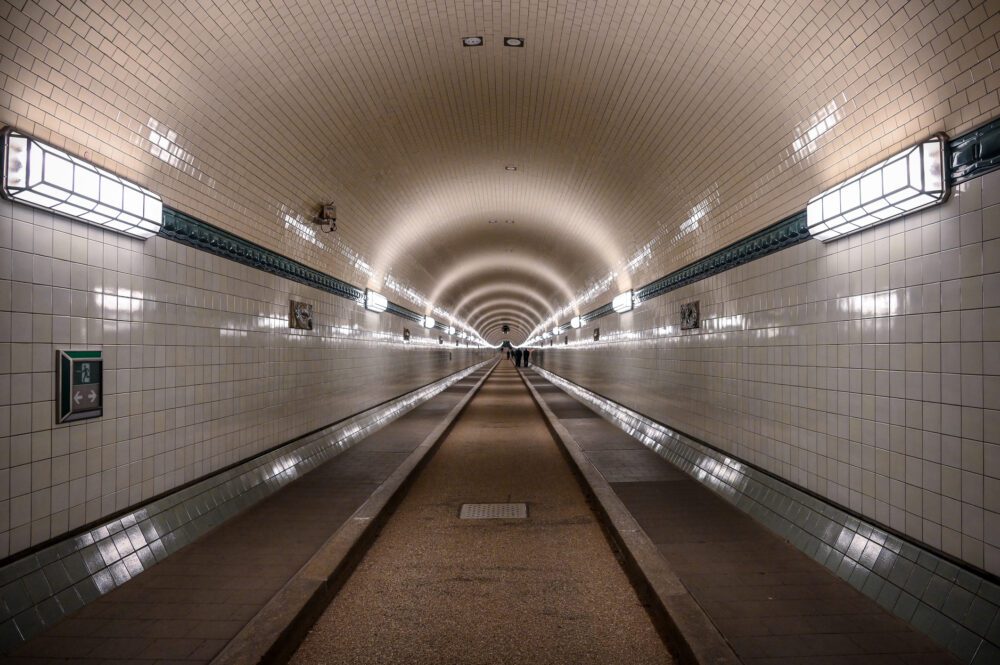
The Elbe Tunnel, also known as the Old Elbe Tunnel or Alter Elbtunnel, is a historic landmark in Hamburg that offers visitors a unique underground experience beneath the Elbe River. Opened in 1911, the tunnel was an engineering marvel of its time, providing pedestrians and cyclists with a direct passage beneath the river to connect the city centre with the port area on the opposite bank. Designed by architects Raabe, Kockelkorn, and Oechelhaeuser, the Elbe Tunnel features impressive brick-lined tunnels that extend over 400 meters in length and are accessed via ornate entrance buildings on either side of the river. Today, the Elbe Tunnel remains in operation as a pedestrian and bicycle thoroughfare, offering a fascinating glimpse into Hamburg’s industrial past and providing a convenient and scenic route for commuters and tourists alike.
Practical tip: To experience the historic charm of the Elbe Tunnel, start your journey at one of the entrance buildings located on either side of the river – Landungsbrücken in St. Pauli or Steinwerder in Altona. Be prepared for a stroll or bike ride through the tunnel, as the tunnels are wide enough to accommodate pedestrians and cyclists travelling in both directions. Be sure to admire the intricate details of the tunnel’s architecture, including the ornate tilework, decorative light fixtures, and historic signage that harken back to the tunnel’s early 20th-century origins.
Hamburg Fischmarkt
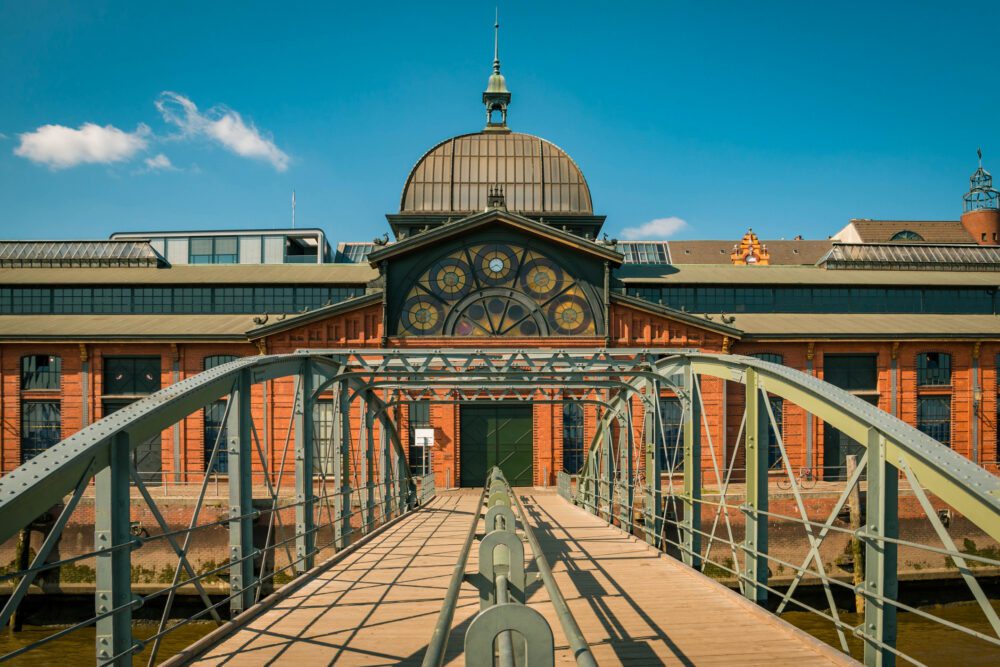
The Hamburg Fish Market, or Fischmarkt, is a vibrant and bustling market that has been a Hamburg institution for over 300 years. Dating back to the 18th century, the Fish Market began as a way for local fishermen to sell their catch directly to the public and has since evolved into a lively weekly event that attracts visitors from far and wide. Held every Sunday morning from 5:00 am to 9:30 am, the market offers a unique blend of fresh seafood, local produce, flowers, and a lively atmosphere that reflects the city’s maritime heritage. Visitors to the Hamburg Fish Market can browse through stalls overflowing with a wide variety of seafood, from freshly caught fish and shellfish to smoked salmon, herring, and caviar, as well as sample local delicacies such as Fischbrötchen (fish sandwiches) and seafood snacks.
I recommend arriving early in the morning when the market is at its busiest. Be sure to bring cash, as many vendors may not accept credit cards. Consider sampling some of the market’s delicious seafood offerings for breakfast, such as the famous Fischbrötchen or a hearty fish soup, served piping hot from one of the market stalls. After exploring the market, take time to wander along the scenic waterfront promenade, where you’ll find stunning views of the Elbe River and the bustling harbour activity. And don’t miss the chance to enjoy live music and entertainment from local bands and street performers, adding to the festive atmosphere of the market.
Reeperbahn
Embark on a scenic journey through Hamburg’s waterways with an Alster Lake cruise, a beloved tradition that offers a unique perspective of the city’s stunning skyline and historic landmarks. The Alster Lake, a vast artificial lake located in the heart of Hamburg, has been a focal point of the city’s landscape since the 12th century when it was created as a reservoir to supply water to the city’s mills. Today, the lake serves as a popular recreational spot, with its tranquil waters offering the perfect setting for leisurely boat cruises and water sports. During your cruise, you’ll glide past iconic landmarks such as the Alster Fountain, the historic Alsterhaus, and the picturesque Alsterpark, while enjoying panoramic views of the city’s bustling harbour and waterfront districts.
Be sure to check the cruise schedule and departure times in advance, as well as any special events or themed cruises that may be available during your visit. Opt for a cruise that includes informative commentary in multiple languages, allowing you to learn about the history, architecture, and culture of Hamburg as you sail along the scenic waterways. For a truly memorable experience, choose a sunset cruise and watch as the sun dips below the horizon, casting a golden glow over the city skyline. And don’t forget to bring a camera to capture the breathtaking views and memorable moments as you cruise along the tranquil waters of Alster Lake.
Port of Hamburg Cruise
The Port of Hamburg, fondly known as the “Gateway to the World,” stands as one of Europe’s largest and most important seaports, boasting a rich history dating back over 800 years. Established in the 12th century as a trading hub along the Elbe River, the port played a vital role in Hamburg’s rise as a global maritime power and economic centre. Today, the Port of Hamburg encompasses a vast network of terminals, docks, and warehouses, handling millions of tons of cargo and welcoming thousands of ships from around the world each year. Visitors to the port can witness the bustling activity of container ships, cruise liners, and cargo vessels, as well as explore the historic Speicherstadt district, a UNESCO World Heritage Site, with its iconic red-brick warehouses and picturesque canals.
Consider taking a guided boat tour or harbour cruise, which offers panoramic views of the port’s facilities and the bustling activity along the waterfront. Be sure to visit the Hamburg Cruise Center in the HafenCity district, where you can watch as cruise ships from around the world dock at the terminal, or take a stroll along the Elbe River promenade for stunning views of the port and the city skyline. For an insider’s perspective, consider joining one of the port’s guided tours, where you can learn about the history, operations, and significance of the port from knowledgeable guides.
Tierpark Hagenbeck
Tierpark Hagenbeck, located in the heart of Hamburg, is a historic zoo renowned for its innovative approach to animal conservation and welfare. Founded in 1907 by Carl Hagenbeck, a pioneer in the field of zoo design and animal husbandry, Tierpark Hagenbeck was the first zoo in the world to introduce open enclosures that mimic the animals’ natural habitats, rather than traditional cages and bars. Today, the zoo spans over 25 hectares and is home to over 2,500 animals representing more than 300 species, including elephants, lions, polar bears, and giraffes. Tierpark Hagenbeck offers visitors a unique opportunity to observe these magnificent creatures up close in spacious, naturalistic habitats that prioritize their health and well-being.
To maximize your visit to Tierpark Hagenbeck, start your day early to avoid crowds and allow plenty of time to explore the zoo’s extensive grounds and exhibits. Consider purchasing tickets online in advance to skip the ticket queues and save time upon arrival. Be sure to pick up a map of the zoo at the entrance, which will help you navigate the various themed areas and animal exhibits. Don’t miss the chance to attend one of the zoo’s daily feeding sessions and animal shows, where you can learn more about the animals and their behaviours from knowledgeable zookeepers. For a unique experience, consider booking a behind-the-scenes tour or animal encounter, where you can get up close and personal with some of the zoo’s residents and learn about the important conservation work being done at Tierpark Hagenbeck.
St Michael’s Church

St. Michael’s Church, affectionately known as “Michel” by locals, stands as one of Hamburg’s most iconic landmarks and a symbol of the city’s resilience and spirit. Built between 1649 and 1661, St. Michael’s Church has witnessed centuries of history, surviving wars, fires, and natural disasters to emerge as a beacon of hope and faith for the people of Hamburg. The church’s striking Baroque architecture, with its distinctive copper-topped spire soaring over 130 metres into the sky, makes it a prominent feature of the city’s skyline. Inside, visitors can marvel at the opulent interior adorned with ornate altars, intricate wood carvings, and magnificent stained glass windows, as well as explore the crypt, where prominent Hamburgers are laid to rest.
I recommend joining one of the guided tours offered by the church, where knowledgeable guides can provide insights into its architecture, artwork, and significance. Be sure to climb the tower for panoramic views of Hamburg’s skyline and the bustling harbour below, but be prepared for a steep ascent of over 450 steps. For a truly unforgettable experience, attend one of the church’s regular concerts or organ recitals, where you can enjoy performances by world-class musicians in the majestic surroundings of St. Michael’s. And don’t forget to visit the nearby Michelwiese, a scenic park overlooking the Elbe River, where you can relax and enjoy stunning views of the river and the city beyond.
Speicherstadt
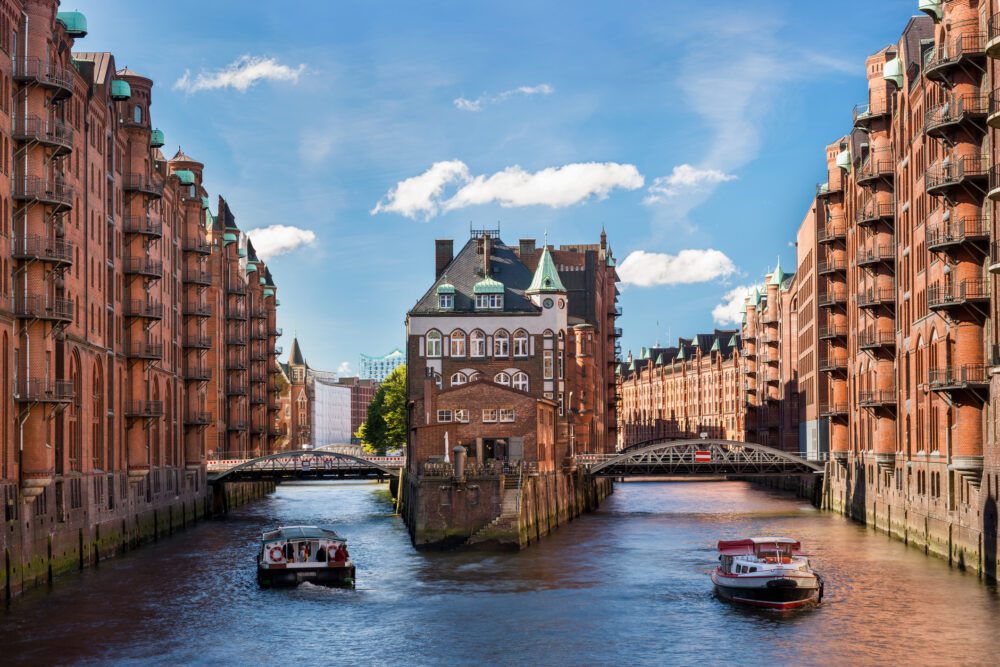
Speicherstadt, or the Warehouse District, stands as a UNESCO World Heritage Site and a testament to Hamburg’s maritime heritage and economic prowess. Constructed in the late 19th and early 20th centuries, Speicherstadt is the largest warehouse complex in the world and a stunning example of neo-Gothic brick architecture. Built on timber-pile foundations and crisscrossed by a network of canals, Speicherstadt once served as the heart of Hamburg’s bustling port, storing goods such as coffee, tea, spices, and carpets from around the world. Today, the district has been transformed into a vibrant cultural and commercial hub, with its red-brick warehouses repurposed into offices, museums, shops, and cafes, while still retaining much of its historic charm and character.
Start your visit at the Speicherstadt Museum, where you can learn about the district’s history and significance through interactive exhibits and displays. Be sure to take a stroll along the cobblestone streets and bridges, pausing to admire the intricate brickwork, ornate facades, and picturesque canals that give Speicherstadt its distinctive character. Consider taking a boat tour through the canals to get a unique perspective of the district from the water, or rent a bicycle and explore the surrounding HafenCity area, where you’ll find modern architecture, waterfront promenades, and trendy restaurants and bars. For a memorable souvenir, stop by one of the many shops selling spices, chocolates, and other goods produced in the district, or indulge in a coffee or a meal at one of the charming cafes or restaurants overlooking the canals.
Book Tickets: 1.5-Hour Harbor and Speicherstadt Day Cruise
Miniatur Wonderland
Miniatur Wunderland is a must-visit attraction in Hamburg, captivating visitors with its intricate miniature world spanning several floors. Founded in 2001 by twin brothers Gerrit and Frederik Braun, Miniatur Wunderland has since grown into the world’s largest model railway exhibition, featuring meticulously crafted landscapes, cities, and scenes from around the globe. The exhibition showcases various regions and themes, including bustling cityscapes, idyllic countryside settings, and iconic landmarks rendered in stunning detail. Visitors can marvel at the elaborate train networks that traverse the miniature landscapes, complete with moving trains, cars, and even aircraft. Each section of Miniatur Wunderland is a testament to the Braun brothers’ passion for model railways and their dedication to creating a truly immersive experience for visitors.
Practical tips for visiting Miniatur Wunderland include booking tickets in advance to avoid long queues, especially during peak tourist seasons. It’s also advisable to allocate sufficient time for exploring the exhibition, as there are numerous intricate details to discover in each section. Visitors of all ages will find something to enjoy at Miniatur Wunderland, from the enchanting miniatures to interactive elements like push-button animations and hidden surprises. Additionally, the attraction offers guided tours and special events, providing further insights into the craftsmanship behind the miniature world.
HafenCity and Elbphilharmonie
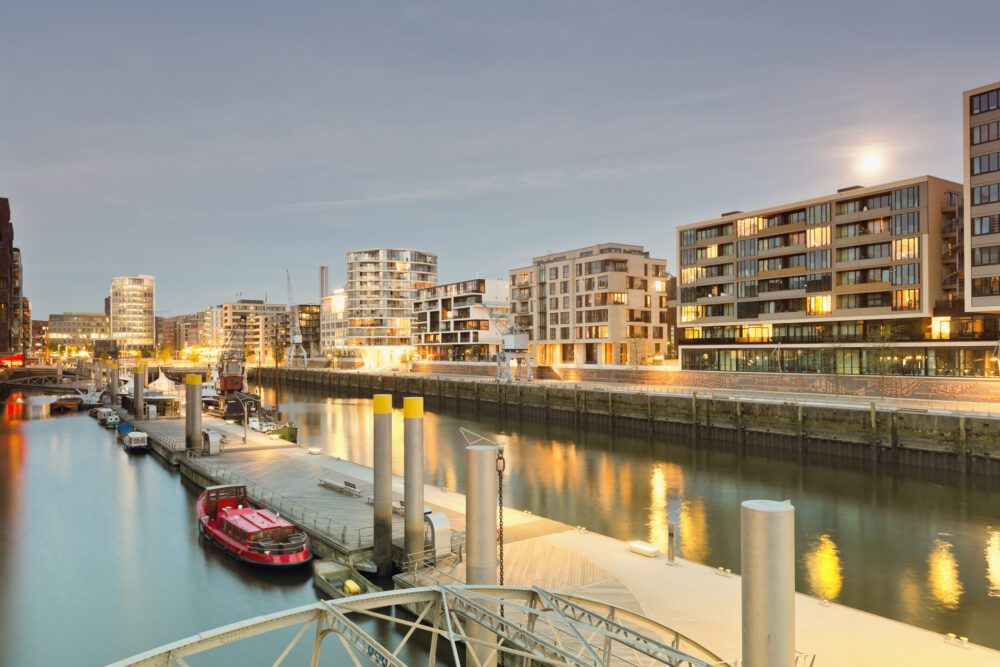
HafenCity, Europe’s largest urban development project, stands as a testament to Hamburg’s vision for the future and its commitment to sustainable urban planning. Situated on the banks of the Elbe River, HafenCity is a vibrant waterfront district that has transformed former industrial land into a modern and dynamic neighbourhood. The project, which began in the early 2000s, has revitalized the area, creating a mix of residential, commercial, and cultural spaces that blend seamlessly with the historic port architecture. Today, HafenCity is home to striking modern buildings, innovative urban design, and a wealth of attractions, including the Elbphilharmonie concert hall, the International Maritime Museum, and the Miniatur Wunderland model railway exhibition.
Start your visit at the HafenCity InfoCenter, where you can learn about the district’s history, architecture, and attractions through interactive exhibits and guided tours. Be sure to take a stroll along the waterfront promenade, which offers stunning views of the Elbe River and the bustling harbour activity. Stop by the Sandtorhafen, a historic harbour basin that has been transformed into a vibrant public space with cafes, shops, and outdoor seating areas. For a unique perspective of the district, consider taking a boat tour through the canals of HafenCity, where you can admire the modern architecture and urban landscape from the water. And be sure to explore the district’s cultural offerings, including art galleries, theatres, and music venues, which showcase the vibrant cultural scene that has emerged in HafenCity.
Book Tickets: Elbphilharmonie Plaza Guided Tour
International Maritime Museum
The International Maritime Museum, nestled in the heart of Hamburg’s historic Speicherstadt district, is a treasure trove of maritime history and nautical artefacts. Housed within the walls of the former Kaispeicher B, a historic warehouse dating back to the late 19th century, the museum was founded by Peter Tamm Jr., a passionate collector and maritime enthusiast. Since its opening in 2008, the museum has grown to become one of the largest maritime museums in the world, boasting an extensive collection of over 40,000 objects spanning centuries of seafaring history. Visitors to the museum can explore a wide range of exhibits, including model ships, navigation instruments, ship models, and artwork, providing fascinating insights into the history of seafaring, exploration, and naval warfare.
Plan to spend several hours exploring its diverse exhibits and collections. Be sure to start your visit on the upper floors of the museum, where you’ll find exhibits on topics such as ocean liners, merchant shipping, and naval history. Don’t miss the chance to climb to the top of the museum’s iconic tower, which offers panoramic views of the Speicherstadt district and the bustling harbour below. For an immersive experience, consider joining one of the guided tours offered by the museum, where knowledgeable guides can provide insights into the museum’s collections and the history of maritime exploration.
Book Tickets: International Maritime Museum Entrance Ticket
Conclusion
Hamburg offers a wealth of experiences and attractions that cater to every interest and inclination, making it a truly dynamic and vibrant destination for travellers. From exploring historic landmarks like the Rathaus and Speicherstadt to immersing oneself in the city’s rich cultural scene at the Hamburger Kunsthalle and Elbphilharmonie, there is no shortage of memorable experiences to be had in this bustling metropolis.
Hamburg’s picturesque waterfront, including the Alster Lake, Port of Hamburg, and Fish Market, also provide endless opportunities for strolls, scenic boat cruises, and gastronomic delights. Whether you’re a history buff, an art enthusiast, a foodie, or simply seeking to soak in the vibrant atmosphere of a bustling port city, Hamburg’s diverse array of attractions ensures that there is something for everyone to enjoy and discover. With its rich history, cultural heritage, and dynamic spirit, Hamburg truly stands as a city that captivates and inspires all who visit.
